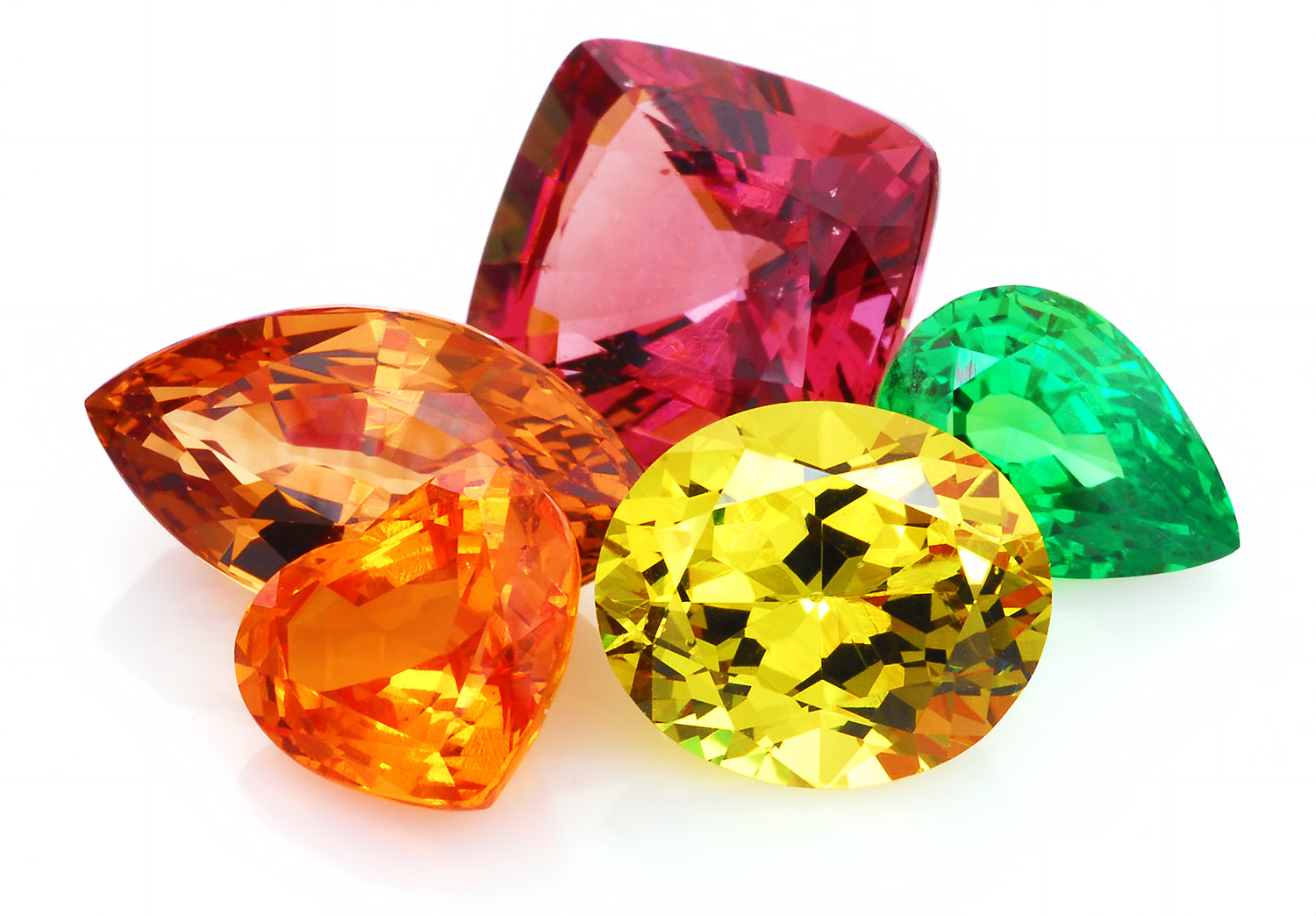All species of garnets possess similar physical properties and crystal forms, but differ in chemical composition. The species names are pyrope, almandine, spessartine, grossular, uvarovite and andradite.

Garnets are isomorphic members of the silicate group of minerals. Their general formula is X3Y2(Si O4)3. The X site is usually occupied elements like Ca2+, Mg2+, and Fe2+ while the Y site is occupied by Al3+, Fe3+, or Cr3+ ions. As most of these cations are similar in size and electrical charge, they are interchangeable in the crystal matrix and it is because of these substitutions which occurred during the process of crystallization, that we see such a large range of colors in garnets. It also explains why there is a considerable variation in the refractive indices as well as the specific gravities. The latter is very important to remember when testing garnets, as no value will be the same and values will fall within a range.
Garnets can be divided into two main groups, the Pyralspite group and the Ugrandite group. The species names represent end positions in a solid solution series where they describe a specific ideal chemistry. Within the series there exists a nearly limitless range of intermediary colors that correspond to the ion substitutions. In general, the Pyralspite group garnets occur in some shade of red, while the Ugrandite garnets are usually some shade of green.
Pyralspite group:
Ugrandite goup:
The end member gemological designations are based on chemistry but as so many of the stones are of mixed compositions and varying colors, a host of trade and varietal names have evolved to describe these other garnets. These intermediary garnets may have some exotic trade names, but a strict definition of boundaries between the groups and the sub groups does not exist.
The list below includes the most important varieties, species, and trade names for garnet:
Alamandite Fe2+3Al2(SiO4)3 Andradite Ca3Fe3+2(SiO4)3 Color Change Garnet [Mg3 + Mn3]AL2(SIO4) + Vanadium Demantoid Ca3Fe3+2(SiO4)3 Grossularite Ca3Al2(SiO4)3 Hessonite Ca3Al2Si3O12 Malaia Garnet [Mg3 + Mn3]AL2(SIO4) Mali Garnet Ca3Al2(SiO4)3 Pyrope Mg3Al2(SiO4)3 Rhodolite Al2(SiO4)3 Spessartite Mn2+3Al2(SiO4)3 Tsavorite Ca3Al2(SiO4)3
and some lesser known species:
Calderite Mn+23Fe+32(SiO4)3 Goldmanite Ca3V3+2(SiO4)3 Henritermierite Ca3Mn3+2(SiO4)2(OH)4 Hibschite Ca3Al2(SiO4)(3-x)(OH)4x (x= 0.2–1.5) Katoite Ca3Al2(SiO4)(3-x)(OH)4x (x= 1.5-3) Kerimasite Ca3Zr2(Fe+3O4)2(SiO4) Kimzeyite Ca3Zr2(Al+3O4)2(SiO4) Knorringite Mg3Cr2(SiO4)3 Majorite Mg3(Fe2+Si)(SiO4)3 Menzerite-(Y) Y2CaMg2(SiO4)3 Momoiite Mn2+3V3+2(SiO4)3 Morimotoite Ca3(Fe2+Ti4+)(SiO4)3 Schorlomite Ca3Ti4+2(Fe3+O4)2(SiO4) Spessartine Mn2+3Al2(SiO4)3 Toturite Ca3Sn2(Fe3+O4)2(SiO4) Uvaravite Ca3Cr2(SiO4)3 Calderite Mn+23Fe+32(SiO4)3 Goldmanite Ca3V3+2(SiO4)3 Henritermierite Ca3Mn3+2(SiO4)2(OH)4 Hibschite Ca3Al2(SiO4)(3-x)(OH)4x (x= 0.2–1.5) Katoite Ca3Al2(SiO4)(3-x)(OH)4x (x= 1.5-3) Kerimasite Ca3Zr2(Fe+3O4)2(SiO4) Kimzeyite Ca3Zr2(Al+3O4)2(SiO4) Knorringite Mg3Cr2(SiO4)3 Majorite Mg3(Fe2+Si)(SiO4)3 Melanite Ca3Fe3+2(SiO4)3 + Titanium Menzerite-(Y) Y2CaMg2(SiO4)3 Momoiite Mn2+3V3+2(SiO4)3 Morimotoite Ca3(Fe2+Ti4+)(SiO4)3 Schorlomite Ca3Ti4+2(Fe3+O4)2(SiO4) Spessartine Mn2+3Al2(SiO4)3 Toturite Ca3Sn2(Fe3+O4)2(SiO4) Uvaravite Ca3Cr2(SiO4)3
Many garnets cannot be identified by color and refractive index alone and some form of spectral analysis is required.
All trademarks and logos shown herein are the property of their respective owners. © Copyright Multicolour Gems Ltd, 1998-2001. All rights reserved. Use of this site constitutes acceptance of Multicolour Return Policy, Privacy Policy and Trading Guarantee. Multicolour.com headquarters at # 59 Soi Pradit, Silom Soi 20, Bangkok, 10500, Kingdom of Thailand, Tel: +66 2 233-2108, Fax: +66 2 236-5274, E-mail to info@multicolour.com. Lost? Check Site Map. Site design and maintenance by NetComposite ®.
|